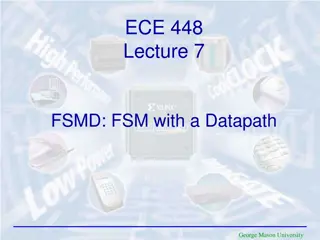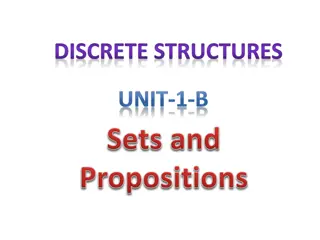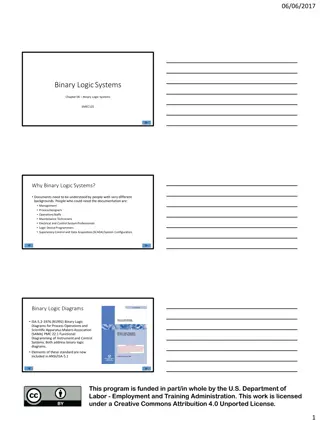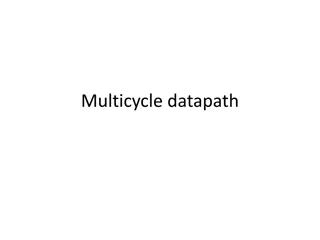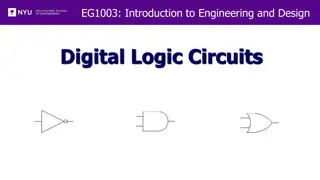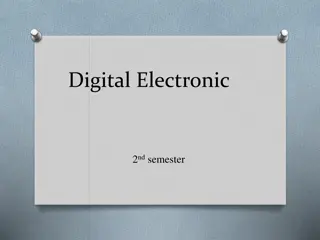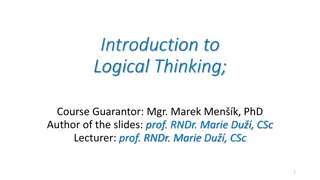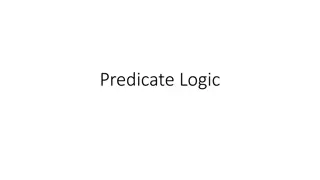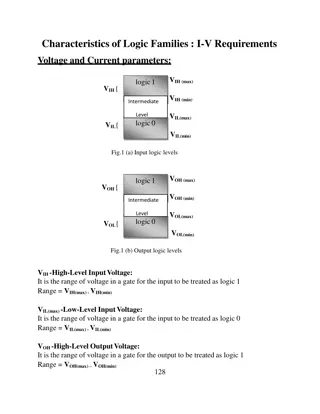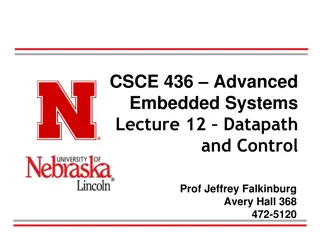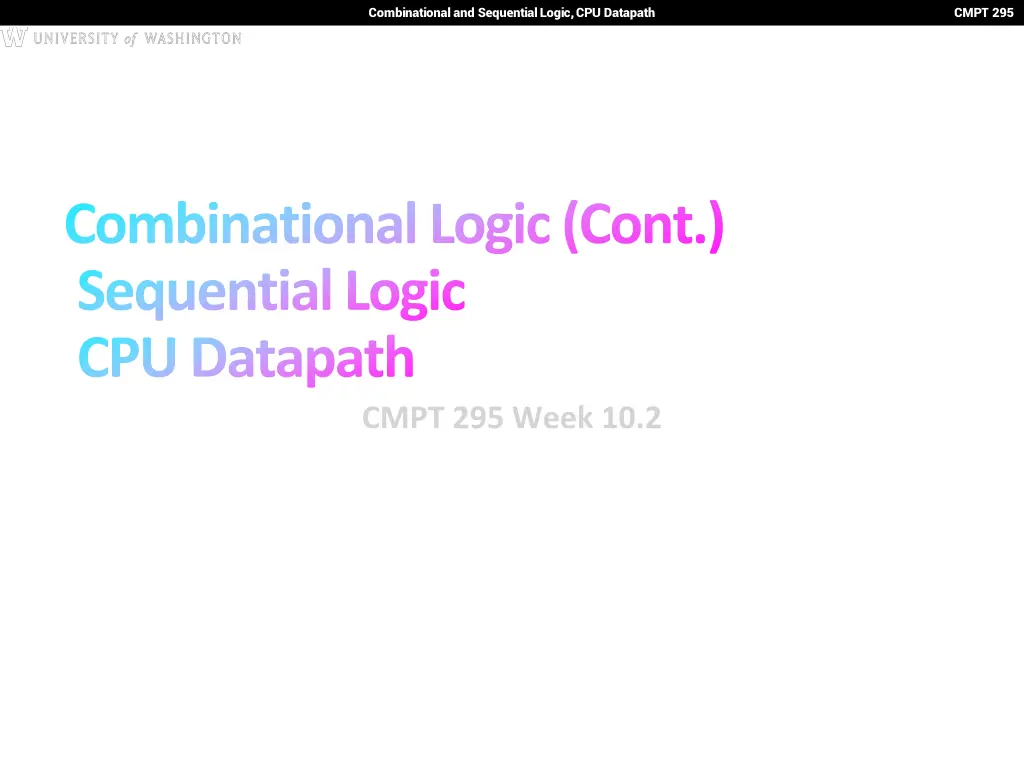
Understanding Combinational and Sequential Logic in CPU Datapath
Explore the concepts of combinational and sequential logic in CPU datapath, simplifying Boolean expressions, using Karnaugh maps for simplification, and examples of simplifying multi-variable expressions. Learn about signal propagation, critical path delays, transistor networks, and more in this in-depth study.
Download Presentation

Please find below an Image/Link to download the presentation.
The content on the website is provided AS IS for your information and personal use only. It may not be sold, licensed, or shared on other websites without obtaining consent from the author. If you encounter any issues during the download, it is possible that the publisher has removed the file from their server.
You are allowed to download the files provided on this website for personal or commercial use, subject to the condition that they are used lawfully. All files are the property of their respective owners.
The content on the website is provided AS IS for your information and personal use only. It may not be sold, licensed, or shared on other websites without obtaining consent from the author.
E N D
Presentation Transcript
Combinational and Sequential Logic, CPU Datapath CMPT 295 Combinational Logic (Cont.) Sequential Logic CPU Datapath CMPT 295 Week 10.2
Combinational and Sequential Logic, CPU Datapath CMPT 295 Simplifying Boolean Expressions Logic Delay: Everything we are dealing with is just an abstraction of transistors and wires Inputs propagating to the outputs are voltage signals passing through transistor networks There is always some delay before a CL s output updates to reflect the inputs Critical Path is longest delay from any input to output. Could be represented as n gate delays Simpler Boolean expressions networks smaller circuit delays hardware smaller transistor faster 2
Combinational and Sequential Logic, CPU Datapath CMPT 295 Simplifying Boolean Expressions: Example 3
Combinational and Sequential Logic, CPU Datapath CMPT 295 Karnaugh Maps Used to simplify Boolean expressions of 2-4 variables Table composed of squares each representing a unique combination of all variable (1 if true, else blank) Two variable Map: ? ? 0 1 ? Example: Boolean Expression? ? 0 1 ? ? ?? 1 0 0 ? ? ?? 1 1 1 1 x + y 4
Combinational and Sequential Logic, CPU Datapath CMPT 295 Three Variable Karnaugh Maps ? ?? 00 01 11 10 ? ? ? ? ? ?? ??? ?? ? 0 ? ? ? ? ?? ??? ?? ? ? 1 ? Question: Simplify ?? + ?? + ? ?? + ?? 5
Combinational and Sequential Logic, CPU Datapath CMPT 295 Example: Simplify 3-Variable Expression Question: Simplify ?? + ?? + ? ?? + ?? ? ?? 00 01 11 10 ? 0 1 1 1 1 1 1 ? ? Answer: ? + ?? 6
Combinational and Sequential Logic, CPU Datapath CMPT 295 Four Variable Karnaugh Maps ? ?? 00 01 11 10 ?? ? ? ? ? ? ? ?? ? ??? ? ?? ? 00 ?? ? ? ?? ?? ???? ??? ? 01 ? ?? ? ? ?? ?? ???? ??? ? 11 ? ? ? ? ? ? ? ?? ? ??? ? ?? ? 10 ? Question: Simplify ?? + ?? + ? ?? + ???? 7
Combinational and Sequential Logic, CPU Datapath CMPT 295 Example: Simplify 4-Variable Expression Simplify ?? + ?? + ? ?? + ???? ? ?? 00 01 11 10 ?? 1 1 1 00 1 1 1 01 ? 1 11 ? 1 1 10 Solution: ?? + ?? + ??+ ?? ? 8
Combinational and Sequential Logic, CPU Datapath CMPT 295 Useful Combinational Circuits 9
Combinational and Sequential Logic, CPU Datapath CMPT 295 Data Multiplexor (MUX) Multiplexor ( MUX ) is a selector Place one of multiple inputs onto output (N-to-1) Shown below is an n-bit 2-to-1 MUX Input S selects between two inputs of n bits each This input is passed to output if selector bits match shown value A 0 n C n B 1 n Represents that this input has n bits S 10
Combinational and Sequential Logic, CPU Datapath CMPT 295 Implementing a 1-bit 2-to-1 MUX Schematic: Boolean Algebra: A 0 n C n B 1 n s 0 0 0 0 1 1 1 1 a 0 0 1 1 0 0 1 1 b 0 1 0 1 0 1 0 1 c 0 0 1 1 0 1 0 1 Circuit Diagram: S Truth Table: 11
Combinational and Sequential Logic, CPU Datapath CMPT 295 1-bit 4-to-1 MUX Schematic: A B C 00 01 10 E 11 D 2 S= S1S0 Truth Table: How many rows? Boolean Expression: E = S1S0A + S1S0B + S1S0C + S1S0D 26 12
Combinational and Sequential Logic, CPU Datapath CMPT 295 Another Design for 4-to-1 MUX Can we leverage what we ve previously built? Alternative hierarchical approach: A 0 B 0 1 E C 1 0 D 1 S1 13 S0
Combinational and Sequential Logic, CPU Datapath CMPT 295 Decoder Enable one of 2N outputs based on N input Example: 2-to-4 decoder By BlueJester0101, CC BY-SA 3.0, https://commons.wikimedia.org/w/index.php?curid=3668293 Use case: Choose ALU operation based on instruction op-code 14
Combinational and Sequential Logic, CPU Datapath CMPT 295 Demultiplexer (Demux) Similar to decoder with an enable signal By BlueJester0101, CC BY-SA 3.0, https://commons.wikimedia.org/w/i ndex.php?curid=3668293 15
Combinational and Sequential Logic, CPU Datapath CMPT 295 Single-Bit Binary Adder (Half Adder) Add A + B to get Sum (S) and Carry (C) Truth Table: Boolean Expressions: S = A B; C = AB Circuit: A B S C 0 0 0 0 0 1 1 0 1 0 1 0 1 1 0 1 By inductiveload - Own work, Public Domain, https://commons.wikimedia.org/w/index.php?curid=1023090 16
Combinational and Sequential Logic, CPU Datapath CMPT 295 What is this Circuit? Truth table: A B S ABC 0 0 0 0 0 1 0 1 0 0 1 1 CS 0 0 0 1 0 1 1 0 3-bit Addition! Half Adder C Half Adder C 1 0 0 1 0 1 1 1 0 1 1 1 0 1 1 1 1 0 0 1 C Q. What s the propagation delay? 3 gate delays (highlighted) Full Adder A B FA C Q. What does the circuit accomplish? Algebra: S S = A S = A B B C; C = AB + C(A C B)
Combinational and Sequential Logic, CPU Datapath CMPT 295 Computing with Combinational Circuits Definition: A combinational circuit computes a pure function, i.e., its outputs react only based on its inputs. There are no feedback loops and no state information (memory) is maintained. Theorem: Every Boolean function can be implemented with NAND and NOT. Circuits are modular a 4-bit ripple carry adder! Adds by columns Propagation delay A3B3 A2B2 A1B1 A0B0 A 4 B 4 C3 C2 C1 = 9 (2n + 1) C4 FA FA FA FA C0 C Adder-4 C 4 S3 S2 S1 S0 S
Combinational and Sequential Logic, CPU Datapath CMPT 295 Functional Unit Hardware circuits are fixed Can t adjust wires /gates while running Build control wires to parametrize its function Function Unit: Function Select: FS func 32 32 0001 A+B 0010 A B 1000 A*B 0100 A^B 0101 A+1 1101 B opA opB 4 FS res 32
Combinational and Sequential Logic, CPU Datapath CMPT 295 Functional Unit: Adder-Subtractor A B 32 FS if FS==0 then S = A+B 32 32 if FS==1 then S = A+B+1 Adder-32 C 32 = A B S
Combinational and Sequential Logic, CPU Datapath CMPT 295 Combinational vs. Sequential Logic Digital Systems consist of two basic types of circuits: Combinational Logic (CL) Output is a function of the inputs only, not the history of its execution Example: add A, B (ALUs) Sequential Logic (SL) Circuits that remember or store information Also called State Elements Example: Memory and registers 21
Combinational and Sequential Logic, CPU Datapath CMPT 295 Accumulator Example An example of why we would need sequential logic SUM S Xi Want: for X1,X2,X3 over time... S = S + Xi Assume: Each X value is applied in succession, one per cycle The sum since time 1 (cycle) is present on S S=0; 22
Combinational and Sequential Logic, CPU Datapath CMPT 295 First Try: Does this work? X S + Feedback No! 1) How to control the next iteration of the for loop? 2) How do we say: S=0 ? 23
Combinational and Sequential Logic, CPU Datapath CMPT 295 Second Try: How About This? Xi A Register is the state element that is used here to hold up the transfer of data to the adder S + Load/Clk register reset 24
Combinational and Sequential Logic, CPU Datapath CMPT 295 Uses for State Elements Place to store values for some amount of time: Register files (like in RISCV) Memory (caches and main memory) Help control flow of information between combinational logic blocks State elements are used to hold up the movement of information at the inputs to combinational logic blocks and allow for orderly passage 25
Combinational and Sequential Logic, CPU Datapath CMPT 295 Registers Same as registers in assembly: Small memory storage locations Data input (can be various bit widths) Data output (can be various bit widths) Write Enable (can it be written to?) Clock input (inputs active only on a clock tick ) Reset (sets value to zero) 26
Combinational and Sequential Logic, CPU Datapath CMPT 295 First State Element: RS Latch When R = 1 and S = 0 Q is 0 When S = 1 and R = 0 Q is 1 When both S and R are 0 Q stays the same When both S and R are 1 Undefined By Napalm Llama - Modification of Wikimedia Commons file R-S.gif (shown below), CC BY 2.0, https://commons.wikimedia.org/w/index.php?curid=4845402 27
Combinational and Sequential Logic, CPU Datapath CMPT 295 RS Latch with Enable Only changes state when E = 1. Stays the same when E = 0 By Inductiveload - Own Drawing in Inkscape 0.43, Public Domain, https://commons.wikimedia.org/w/index.php?curid=873598 28
Combinational and Sequential Logic, CPU Datapath CMPT 295 D Latch Avoids undefined state of RS Latch when R=S=1 Q is set to D when E = 1; Q stays the same when E = 0 Circuit Schematic By Inductiveload - Own work, Public Domain, https://commons.wikimedia.org/w/index.php?cur id=6712594 By Inductiveload - Own work, Public Domain, https://commons.wikimedia.org/w/index.php?curid=6712572 29
Combinational and Sequential Logic, CPU Datapath CMPT 295 D Flip-Flop Changes state only on falling edge of Clock (i.e., Clock changes from 1 to 0) Use Clock to change on rising edge By Nolanjshettle at English Wikipedia, CC BY-SA 3.0, https://commons.wikimedia.org/w/index.php?curid=40852395 30
Combinational and Sequential Logic, CPU Datapath CMPT 295 Signals and Waveforms: Clocks Clock period (CPU cycle time) Voltage 1 T = T ????????? High Low Rising Edge Falling Edge Time Signals transmitted over wires continuously Transmission is effectively instantaneous Implies that any wire only contains one value at any given time 31
Combinational and Sequential Logic, CPU Datapath CMPT 295 Dealing with Waveform Diagrams Easiest to start with CLK on top Solve signal by signal, from inputs to outputs Can only draw the waveform for a signal if all of its input waveforms are drawn When does a signal update? A state element updates based on CLK triggers A combinational element updates ANY time ANY of its inputs changes 32
Combinational and Sequential Logic, CPU Datapath CMPT 295 Accumulator 2nd Try: How About This? Xi S + Load/Clk register reset Load/Clk Xi X0 X0+X1 X0+X1 +X2 X0+X1+ X2+X3 S X0 X0+X1 Delay through Adder Time 33
Combinational and Sequential Logic, CPU Datapath CMPT 295 Register Internals D (n-bit) dn-1 d1 d0 FF FF FF Register CLK CLK CLK CLK q q Q(n-bit) q N-bit register n instances of a Flip-Flop Output flips and flops between 0 and 1 Specifically this is a D-type Flip-Flop D is data input , Q is data output A group of wires when interpreted as a bit field is called a bus 34
Combinational and Sequential Logic, CPU Datapath CMPT 295 CLK Flip-Flop Timing Behavior d q FF 35
Combinational and Sequential Logic, CPU Datapath CMPT 295 CLK Flip-Flop Timing Behavior d q FF Setup Time 36
Combinational and Sequential Logic, CPU Datapath CMPT 295 CLK Flip-Flop Timing Behavior d q FF Hold Time 37
Combinational and Sequential Logic, CPU Datapath CMPT 295 CLK Flip-Flop Timing Behavior d q FF Clock-to-Q 38
Combinational and Sequential Logic, CPU Datapath CMPT 295 Accumulator Revisited: Proper Timing Xi Reset signal shown In practice Xi might not arrive to the adder at the same time as Si-1 Si temporarily is wrong, but register always captures correct value In good circuits, instability never happens around rising edge of CLK Si + Si-1 Clk register reset Undefined (unknown) signal Reset CLK X0+X1 +X2 Si-1 0 X0 X0+X1 Xi X0 X1 X2 X3 X0+X1 +X2 X0+X1+ X2+X3 Si X0 X0+X1 39
Combinational and Sequential Logic, CPU Datapath CMPT 295 Timing Terms Clock: Steady square wave that synchronizes system Register: Several bits of state that samples on rising edge of Clock (positive edge-triggered); also has RESET Setup Time: When input must be stable before Clock trigger Hold Time: When input must be stable after Clock trigger Clock-to-Q Delay: How long it takes output to change from Clock trigger 40
Combinational and Sequential Logic, CPU Datapath CMPT 295 Digital State Machines inputs Memory holds state information current state combinational circuit outputs memory next state compute next state based on (current state, inputs) compute outputs based on (current state, inputs) Q. What does this imply about the clock period? clock period must exceed (tpd of combinational circuit + tpd of registers) where tpd is propagational delay
Combinational and Sequential Logic, CPU Datapath CMPT 295 Waveform Example: RS Latch By Napalm Llama - Modification of Wikimedia Commons file R- S.gif (shown below), CC BY 2.0, https://commons.wikimedia.org/w /index.php?curid=4845402 a 0 0 1 1 b 0 1 0 1 a NOR b 1 0 0 0 Q ? R S 42 Time
Combinational and Sequential Logic, CPU Datapath CMPT 295 Waveform Example: D Flip-Flop By Nolanjshettle at English Wikipedia, CC BY-SA 3.0, https://commons.wikimedia.org/w/index.php?curid=40852395 Q ? D Clock 43 Time
Combinational and Sequential Logic, CPU Datapath CMPT 295 CPU Hardware Goal: Given an instruction set architecture, construct a machine that reliably executes instructions. Design choices will influence speed of instructions: Some instructions will be faster than others Order of instructions may matter conflicts or hazards Order of memory accesses may matter
Combinational and Sequential Logic, CPU Datapath CMPT 295 Model for Synchronous Systems Combinational logic blocks separated by registers Clock signal connects only to sequential logic elements Feedback is optional depending on application How do we ensure proper behavior? How fast can we run our clock? 45
Combinational and Sequential Logic, CPU Datapath CMPT 295 Maximum Clock Frequency Assumes Max Delay > Hold Time Max Delay = CLK-to-Q Delay + CL Delay + Setup Time Min Period = Max Delay Max Freq = 1/Min Period 46
Combinational and Sequential Logic, CPU Datapath CMPT 295 The Critical Path The critical path is the longest delay between any two registers in a circuit The clock period must be longer than this critical path, or the signal will not propagate properly to that next register + Reg Reg
Combinational and Sequential Logic, CPU Datapath CMPT 295 How do we go faster? Pipelining! Split operation into smaller parts and add a register between each one. 48
Combinational and Sequential Logic, CPU Datapath CMPT 295 RISC-V CPU Datapath, Control Intro
Combinational and Sequential Logic, CPU Datapath CMPT 295 CPU Design Principles 1) Analyze instruction set datapath requirements 2) Select set of datapath components & establish clock methodology 3) Assemble datapath meeting the requirements 4) Analyze implementation of each instruction to determine setting of control points that effects the register transfer 5) Assemble the control logic Formulate Logic Equations Design Circuits Processor Input Control Memory Datapath Output 50




